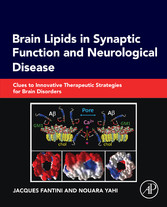Suchen und Finden
Mehr zum Inhalt

Brain Lipids in Synaptic Function and Neurological Disease - Clues to Innovative Therapeutic Strategies for Brain Disorders
Brain Membranes
Abstract
In this chapter you will learn why and how lipids have the unique capability to self-organize into various superstructures, from micelles to membrane bilayers. Basic principles of the physicochemical properties of lipids are explained in simple terms. We offer a didactic step-by-step overview of fundamental concepts such as the hydrophobic effect, lipid molecular shapes and packing parameters, melting temperature, membrane fluidity, lipid phases and miscibility, hexagonal organization, membrane asymmetry, and curvature effects. The noncovalent attractive forces that stabilize specific lipid–lipid complexes and larger lipid assemblies are carefully described. The role of cholesterol in both liquid-disordered (Ld) and liquid-ordered (Lo) phases of the plasma membrane is also discussed. Schematic models of membranes with increasing complexity gradually emerge from this overview, leading to the final description of the plasma membrane of glial cells (oligodendrocytes, astrocytes) and neurons that express specific and distinct patterns of glycosphingolipids in their lipid raft domains.
Keywords
Outline
2.1 Why Lipids are Different from all Other Biomolecules 29
2.2 Role of Structured Water in Molecular Interactions 30
2.3 Lipid Self-Assembly, a Water-Driven Process? 31
2.4 Lipid–Lipid Interactions: Why Such a High Specificity? 35
2.4.1 Melting Temperature of Lipids 36
2.4.2 The Molecular Shape of Lipids 38
2.5 Nonbilayer Phases and Lipid Dynamics 45
2.6 The Plasma Membrane of Glial Cells and Neurons: The Lipid Perspective 45
2.7 Key Experiments on Lipid Density 49
References 49
2.1. Why lipids are different from all other biomolecules
2.2. Role of structured water in molecular interactions
Consider two proteins, A and B, in solution in water (water molecules of the bulk solvent are represented as blue disks). Each of these proteins has a complementary binding site for the other one, yet initially both binding sites are covered with a layer of bound water (represented as purple disks). The binding reaction is possible only if these water molecules initially interacting with the binding sites are displaced (arrows) and redistributed randomly in the bulk solvent, thereby inducing an increase of entropic disorder. Note that the water molecules bound to regions of proteins A and B not involved in binding (represented as dark blue disks) are not affected by the process.
2.3. Lipid self-assembly, a water-driven process?
Alle Preise verstehen sich inklusive der gesetzlichen MwSt.












